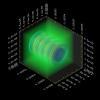Accelerator Modeling
Particle accelerators are among the largest, most complex, and most important scientific instruments in the world. Critical to research in basic sciences such as high energy physics, nuclear physics, materials science, chemistry, and biology, they have enabled a wealth of advances in applied science and technology, many of which have huge economic consequences or are greatly beneficial to society. Given the remarkable importance of particle accelerators, it is imperative that extreme scale computing technologies such as those at NERSC be used for their design, optimization, commissioning, and operation.
Representative examples of such investigations follow.
Advanced Modeling for Particle Accelerators
The SciDAC Community Petascale Project for Accelerator Science and Simulation (COMPASS) Project uses NERSC to run a powerful suite of parallel simulation tools representing a paradigm shift in computational accelerator science. Read More »
Laser Wakefield Particle Acceleration
Laser wakefield acceleration shows great promise for reducing the cost and size of next-generation electron and positron accelerators used as light-sources -- accelerators that generate X-rays for research in physics, material science, biology, chemistry, environmental science, and even archaeology. Simulation at NERSC plays a key role in understanding beam dynamics and propagation, evaluating controlled injection, and improving interpretation of diagnostics. Read More »
Reframing Accelerator Simulations
Taking advantage of special relativity, a new computational method results in up to 300-fold speedup of plasma-based accelerator simulations. Read More »
Modeling Laser Wakefield Accelerators in a Lorentz Boosted Frame
The "Lorentz boosted frame" method was introduced by researchers at LBNL and has resulted in 1,000,000-fold speedups for some simulations. Read More »







